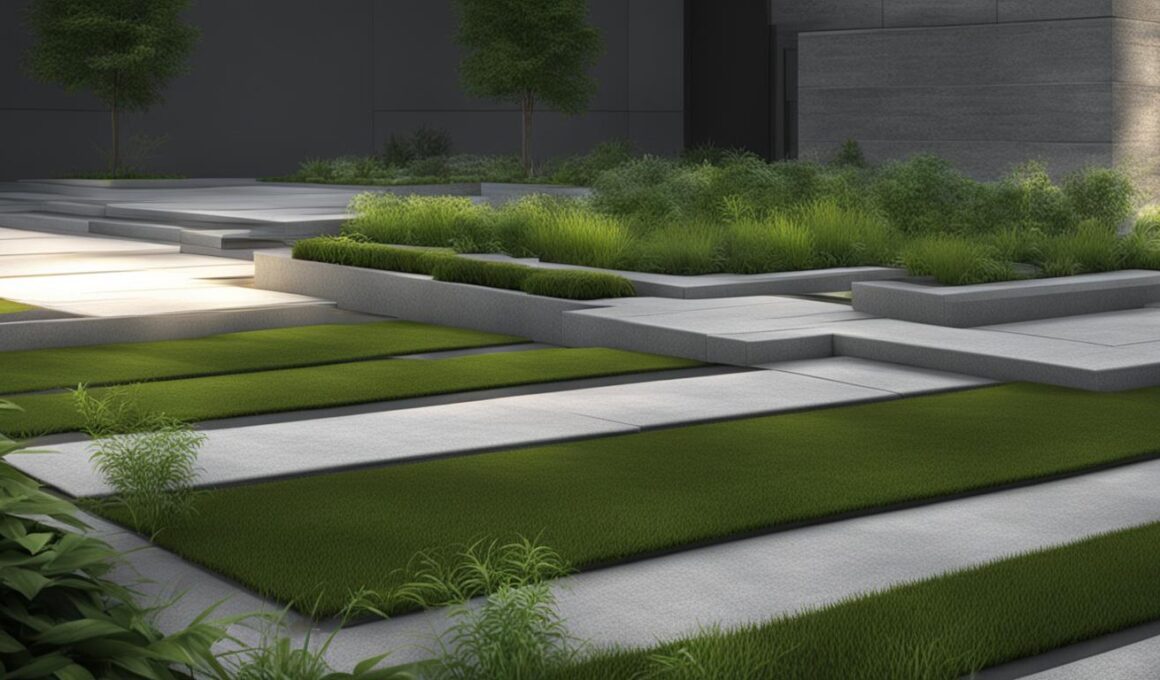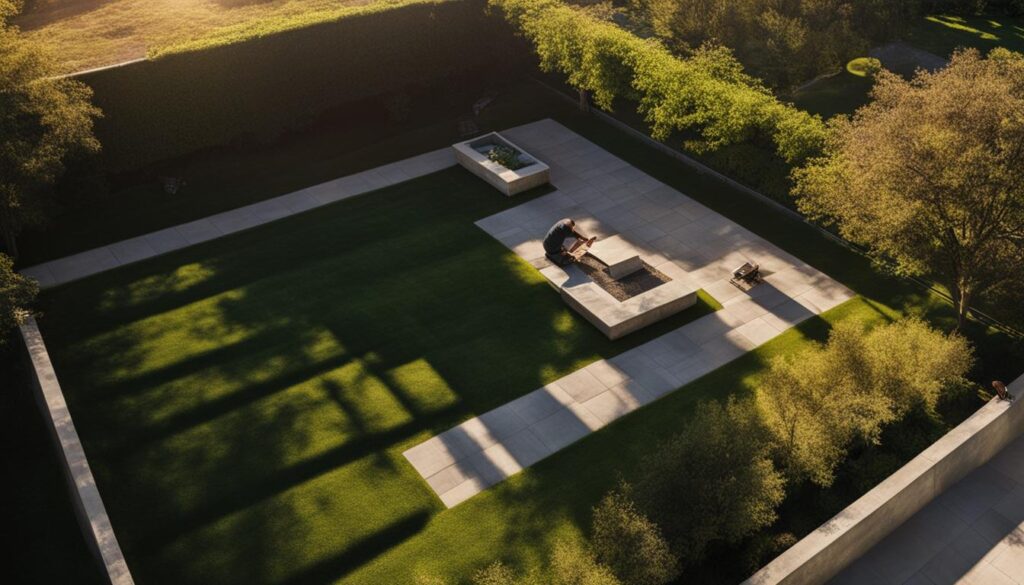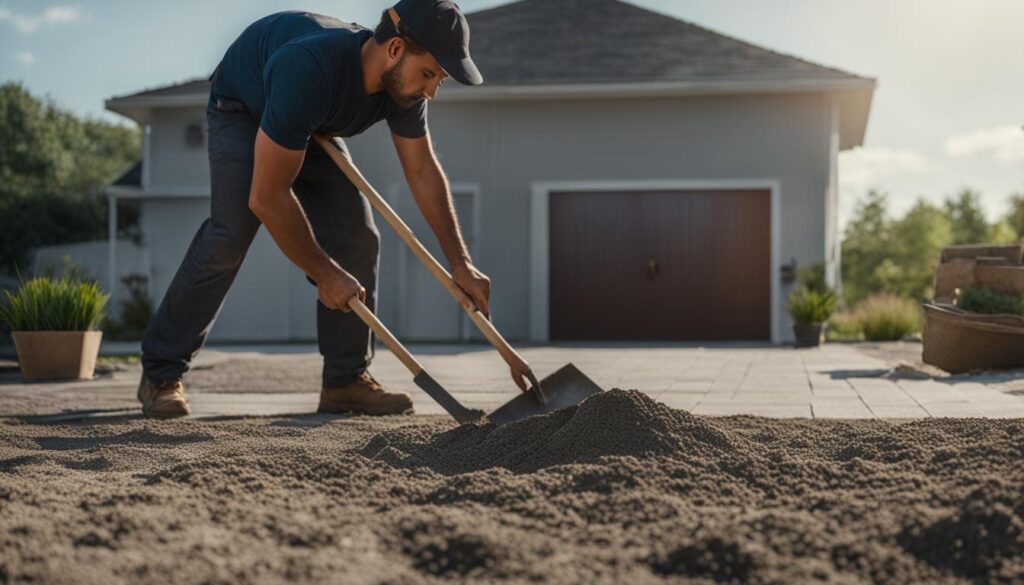Are you considering installing a walkway or patio in your backyard? If so, you might be wondering if it’s possible to place concrete pavers on grass. The answer is yes, it can be done! However, there are a few important steps to keep in mind for a successful installation.
Before you begin, it’s essential to create a layout and mark where each paver will be placed. This will ensure a precise and aesthetically pleasing result. Additionally, smothering the grass with black plastic sheeting for a few weeks will kill the grass and prevent future growth. Once you remove the plastic, it’s time to level the area and create a solid base.
Next, you’ll want to lay paver edging to define the spaces for your pavers. This will help keep them in place and prevent shifting. Adding a layer of sand and compacting it will provide stability and prevent any movement. Finally, it’s time to lay the pavers and seal the joints if necessary.
While installing concrete pavers on grass can be a DIY project, hiring a professional landscaper can ensure proper installation and save you time and effort.
Post Summary:
- Installing concrete pavers on grass is possible with the right steps and preparation.
- Create a layout and mark where each paver will be placed.
- Kill the grass by smothering it with black plastic sheeting for a few weeks.
- Level the area, create a solid base, and lay paver edging to prevent shifting.
- Adding a layer of sand and compacting it will provide stability.
- Lay the pavers and seal the joints if necessary.
- Hiring a professional landscaper can ensure proper installation and save you time and effort.
Steps to Laying Pavers on Grass
If you’re looking to create a beautiful walkway or patio in your backyard without digging, laying pavers on grass can be a great option. Follow these steps to ensure a successful installation:
- Create the layout: Use a measuring tape and string or cardboard to create the layout for your walkway or patio. Walk the path to ensure it feels comfortable, and make any necessary adjustments.
- Kill the grass: Smother the grass with black plastic sheeting for at least four weeks to kill it and prevent future growth.
- Level the ground: After removing the plastic, clear any remaining grass and level the ground to ensure a smooth surface.
- Create a solid base: Use a tamping tool or paver compactor to create a solid base. This will provide stability and prevent shifting over time.
- Lay paver edging: Install paver edging to define the spaces for your pavers and create a clean, finished look.
- Add a layer of sand: Spread a layer of sand over the area to create a level base for your pavers. This will also act as a weed barrier.
- Lay the pavers: Finally, lay the pavers inside the edging, following your desired pattern or design.
- Seal the joints: If necessary, use paver sealer to secure the joints and provide additional stability.
By following these steps, you can achieve a beautiful and durable paver installation on grass. Remember to take your time and pay attention to detail for the best results. Whether you’re creating a walkway or a patio, this DIY project can transform your backyard into a functional and inviting space.
Pros and Cons of Laying Pavers on Grass
| Pros | Cons |
|---|---|
| Pavers can create a durable and long-lasting surface. | The process of smothering the grass and preparing the area can be time-consuming. |
| Pavers add aesthetic appeal to your backyard. | There is a risk of uneven settling over time if the ground is not properly prepared. |
| Pavers are easy to maintain and don’t require mowing or watering. | There might be additional costs associated with purchasing the necessary materials and tools. |
| Pavers can be arranged in various patterns and designs to create a unique look. | The installation process may require physical labor and DIY skills. |
When deciding whether to lay pavers on grass, consider the pros and cons carefully. It’s essential to assess your own skills, available time, and budget before starting the project. If you’re not confident in your abilities or prefer to have a professional take care of the installation, hiring a landscaper can ensure a smooth and successful paver installation.
Prepping to Lay Pavers on Grass
Before you start laying pavers on grass, there are a few important factors to consider. One of the main concerns is erosion. If your yard suffers from erosion or has shifting soil, it may not be the best idea to install pavers on grass. Over time, the ground movement can cause the pavers to become uneven and compromise the stability of your walkway or patio.
Another important consideration is the choice of pavers. There are different types of pavers available, including natural options like fieldstone, flagstone, limestone, bluestone, and travertine. These natural choices can give your outdoor space a rustic and organic feel. On the other hand, if you prefer a more modern look, you can opt for brick pavers or ultra-modern concrete pavers.
When deciding on the type of pavers, consider the aesthetic you want to achieve and the level of maintenance you’re willing to undertake. Natural stone pavers may require more upkeep, while concrete pavers are generally more low-maintenance. Additionally, consider the durability of the pavers and their ability to withstand the elements and heavy foot traffic.
Pros and Cons of Different Paver Choices
| Paver Type | Pros | Cons |
|---|---|---|
| Natural Stone | – Organic and rustic look – Wide variety of colors and textures |
– Requires more maintenance – Can be more expensive |
| Brick | – Classic and elegant appearance – Durable and long-lasting |
– Limited color options – May require sealing |
| Concrete | – Modern and versatile – Low-maintenance – Cost-effective |
– Limited color options – Can fade over time |
By considering the condition of your lawn, the durability of the pavers, and your desired aesthetic, you can make an informed decision when prepping to lay pavers on grass. Remember to choose the type of pavers that best suits your needs and to address any potential erosion issues to ensure a successful installation.
DIY Paving Over Grass vs. Hiring a Pro
When it comes to laying pavers on grass, you have the option to either take on the project yourself or hire a professional. Both choices have their own pros and cons, so it’s important to consider your own skills, budget, and time constraints before making a decision.
DIY Paving
The DIY route can be a cost-effective choice, as it allows you to save on labor costs. By taking on the project yourself, you have control over the entire process and can work at your own pace. However, keep in mind that laying pavers on grass requires physical labor, such as digging up the grass, leveling the ground, and laying the pavers. It can be time-consuming, especially if you have limited experience with landscaping projects.
Additionally, tackling the project yourself means you may need to invest in tools and equipment, such as a compactor, which can add to the overall cost. It’s important to evaluate your own DIY skills and determine if you have the necessary knowledge and resources to successfully complete the job.
Hiring a Pro
If you’re short on time or prefer to leave the work to the experts, hiring a professional landscaper is a viable option. They have the experience and expertise to ensure proper installation and can save you time and effort. A professional will take care of all the steps involved in laying pavers on grass, from creating a layout to leveling the ground and securing the pavers.
However, it’s important to note that hiring a pro comes with a cost. Labor costs can vary depending on the size and complexity of the project, so it’s essential to get multiple quotes and compare prices. Keep in mind that while hiring a professional may be more expensive upfront, it can save you from potential mistakes and the need for costly repairs down the road.
Ultimately, the decision between DIY paving over grass and hiring a pro depends on your own skills, budget, and time availability. Whether you choose to take on the project yourself or enlist the help of a professional, the end result will be a beautiful walkway or patio that enhances your backyard and adds value to your home.
Pros and Cons of DIY Paving vs. Hiring a Pro
| DIY Paving | Hiring a Pro |
|---|---|
| Cost-effective | Expertise and experience |
| Control over the process | Saves time and effort |
| Requires physical labor | Higher upfront cost |
| May need to invest in tools | Potential for costly repairs |
| Time-consuming |
The Benefits of Installing Pavers Instead of Grass
When it comes to landscaping your backyard, installing pavers instead of grass offers a range of benefits. Whether you’re looking for durability, aesthetics, or easier maintenance, pavers can be a great choice. Here are some key advantages to consider:
Enhanced Durability:
Pavers are known for their durability and ability to withstand heavy objects and foot traffic without damage. Unlike grass, which can become worn or damaged over time, pavers provide a stable and long-lasting surface. This makes them ideal for high-traffic areas like walkways or patios, ensuring they remain functional and attractive for years to come.
Aesthetic Appeal:
Installing pavers adds color, texture, and visual interest to your yard. With a wide variety of styles, colors, and sizes available, you can create a unique look that complements your home’s architecture and your personal style. Whether you prefer a classic pattern or a more modern design, pavers offer endless possibilities for customization, allowing you to create a beautiful and inviting outdoor space.
Easy Maintenance:
Unlike with grass, maintaining pavers is a breeze. You won’t need to mow, water, or fertilize them, saving you time and effort. Additionally, pavers don’t become muddy in wet weather, providing a clean and dry surface year-round. Any spills or stains can be easily cleaned with soap and water, ensuring your outdoor space always looks pristine and well-maintained.
Overall, installing pavers instead of grass provides a range of benefits, from enhanced durability to easy maintenance. They offer a versatile and attractive solution for creating walkways, patios, or any other outdoor area in your backyard. Consider the advantages of pavers and transform your yard into a functional and beautiful space.
Conclusion
In conclusion, installing concrete pavers on grass can be a viable and attractive option for transforming your backyard. By following the necessary steps, you can create a stable and functional walkway or patio. However, it is important to consider the condition of your lawn and choose the right type of pavers for your project.
Whether you decide to tackle the installation yourself or hire a professional landscaper, pavers offer a range of benefits compared to traditional grass. They provide durability, withstanding heavy objects and foot traffic without damage. Additionally, pavers add aesthetic appeal to your yard, with various colors and patterns to choose from.
Furthermore, pavers require minimal maintenance, eliminating the need for mowing and watering. Unlike grass, pavers do not become muddy in wet weather, ensuring a cleaner and more enjoyable outdoor space. With their affordability and versatility, pavers are an excellent choice for landscaping your backyard.
FAQ
Can you place concrete pavers on grass?
Yes, it is possible to install concrete pavers on grass to create a walkway or patio in your backyard.
What are the steps to laying pavers on grass?
First, create a layout and mark where each paver will go. Then, smother the grass with black plastic sheeting to kill it. After removing the plastic, level the area, create a solid base, and lay paver edging. Add a layer of sand and compact it for stability. Finally, lay the pavers and seal the joints if necessary.
What factors should I consider before laying pavers on grass?
Factors to consider include the condition of your lawn and the type of pavers you choose. If your yard suffers from erosion or shifting soil, this may not be the best option.
Should I hire a professional or DIY the project?
It depends on your skills and preferences. DIY can save on labor costs, but hiring a professional ensures proper installation and saves time and effort.
What are the benefits of installing pavers instead of grass?
Pavers are more durable, add color and texture to your yard, and are easy to maintain. They also offer a wide variety of styles, colors, and sizes at a budget-friendly price.










